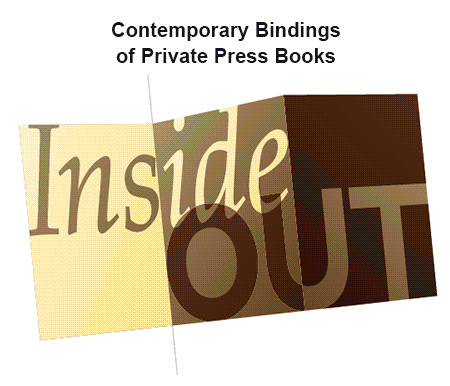A compelling show of Contemporary Bindings of Private Press Books is on display June 6th to July 5th at the San Francisco Center for the Book on the south side of the San Francisco at 375 Rhode Island Street. With only a few days left it is a show worth seeing. This is the last stop for a show that began last year in London and has since played in Cambridge, Massachusetts at the Houghton, in Minneapolis at the Minnesota Center for Book Arts, in New York at Bonhams on Madison Avenue and now in the city by the bay. Two threads intertwine here; the art of bookbinding and the two communities who appreciate these achievements; they who craft these bindings and they who buy them. These bindings are both craft and art.
In France these bindings are an art form. Elsewhere they are important but also often underappreciated. As Simon Eckles, who organized the travelling show, said in a speech he gave on opening night in San Francisco “we have enough binders but not enough collectors.” Part of the situation is that what is collected tends to be older bindings from famous binders. The items in this exhibition, most of which are for sale, are new and have yet to develop a collector’s patina. Nevertheless they are very appealing. And I’m reminded that an exhibition of French impressionists in New York in the early years of the 20th century also went mostly unremarked and the material mostly unsold. Sometimes you simply have to believe your eyes. Some of those paintings occasionally re-surface at auction today and bring tens of millions.
The binding designs in this exhibition are decidedly modern and seem well suited to au-courant collectors. But it is also true that younger well-heeled collectors these days seem to favor auction-determined prices rather than the fixed and sometimes negotiated prices that traditional bookbinders use. To serious collectors this should be no barrier. The value is obvious if subjective. You can believe your eyes.
Hidden or at least less unobserved today is the historically most important category of buyers in the binding field: the libraries. For the past two hundred years binders did restoration and rebinding work for libraries and book dealers but over the past twenty years a desire for “entirely original” works right down to their often-defective bindings has increasingly come into vogue leaving a need for boxes but not for rebinding and repair. So binding opportunities have thinned.
This has apparently not yet diminished the enthusiasm for new professional binders who continue to enter the field even in the face of sometimes-thin markets. At the recent open house about sixty people attended, about 70% of them women, many of them under 40. There is certainly plenty of evidence of life on the artisan-side. What is less certain is where the next generation of collectors will arrive from. If you are potentially one this show is eye-opening.
The bindings are of course the ying to the printer’s yang. Generally, craft-printers seem to be doing well. There are fewer of them of because the cost of entry is high. Letterpress printers have to make significant investments in typesetting, hand type, forms and presses to be in business. I mention this because many of the bindings are created for craft printings.
As we speak, of the 64 items on tour, 35 remain for sale. This makes for 35 very good reasons to visit this exhibition. Among these examples some, a hundred years hence, will be seen as having been the work of prodigies that sold in 2015 for a song, examples that in the next century will be valued and appreciated for their discriminating presentation. A few acquirers will have the eye today both to appreciate these works in the here and now and also to see them for what they will become, celebrated objects that collectors, today not yet born, will someday cherish.
About the exhibit hall
The Center for the Book in San Francisco is an exceptional venue both for this show and for the chance to breath deeply of the scent of printers ink, the unmistakable aroma of ideas, words, and illustrations moving from thought to paper. The open shop has the feeling of a museum though it is an active work place where close to 400 craftsmen teach and several thousand students a year come to learn. The world has moved on to offset and from there to the web but for those who wish the world to be as they remember, here it is – at 375 Rhode Island Street.
So visit this exposition before it decamps. And think about returning from time to time, perhaps to take one of the many classes. The world as it was is still here today.
The San Francisco Center for the Book
375 Rhode Island Street
San Francisco, California 94103
Hours:
July 1st and 2nd: 10-5
July 3rd and 4th: closed
July 5th: 10-5
Link to a pdf introduction to the show




















![<b>Sotheby’s, Dec. 11:</b> Darwin and Wallace. On the Tendency of Species to form Varieties..., [in:] <i>Journal of the Proceedings of the Linnean Society,</i> Vol. III, No. 9., 1858, Darwin announces the theory of natural selection. £100,000 to £150,000. <b>Sotheby’s, Dec. 11:</b> Darwin and Wallace. On the Tendency of Species to form Varieties..., [in:] <i>Journal of the Proceedings of the Linnean Society,</i> Vol. III, No. 9., 1858, Darwin announces the theory of natural selection. £100,000 to £150,000.](https://ae-files.s3.amazonaws.com/AdvertisementPhotos/00d5fd41-2542-4a80-b119-4886d4b9925f.png)




